Visconti-Sforza Tarot
Year: c. 1425
Country of Origin: Italy
Artist: Bonifacio Bembo (attributed)
Designer: N/A
Medium: hand-painted with oil paint, gold, and silver on heavy paper
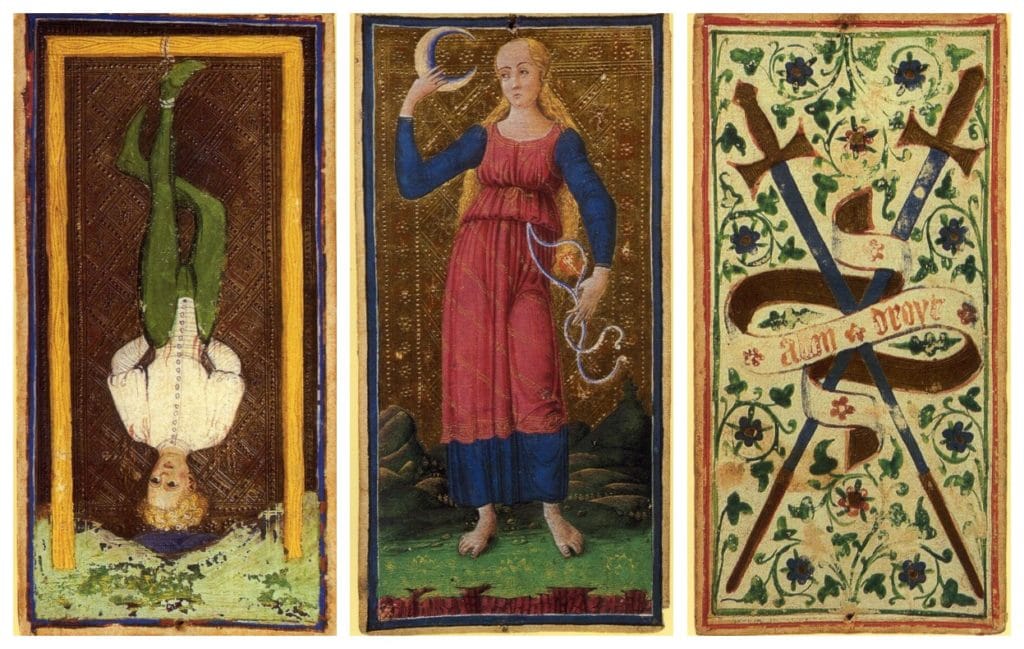
photo source:
The Visconto-Sforza are the oldest tarot cards in the world. Thirty-five cards remain of this beautiful deck, which is remarkable when we consider their age and the delicate nature of the paper they were painted on. It is known as the Visconti-Sforza deck after the Duke of Milan, Filippo Visconti, and his son-in-law, Francesco Sforza, who commissioned the deck in 1425.
While woodblock printed cards existed at this time for the masses, this hand-painted set was both costly and unique.
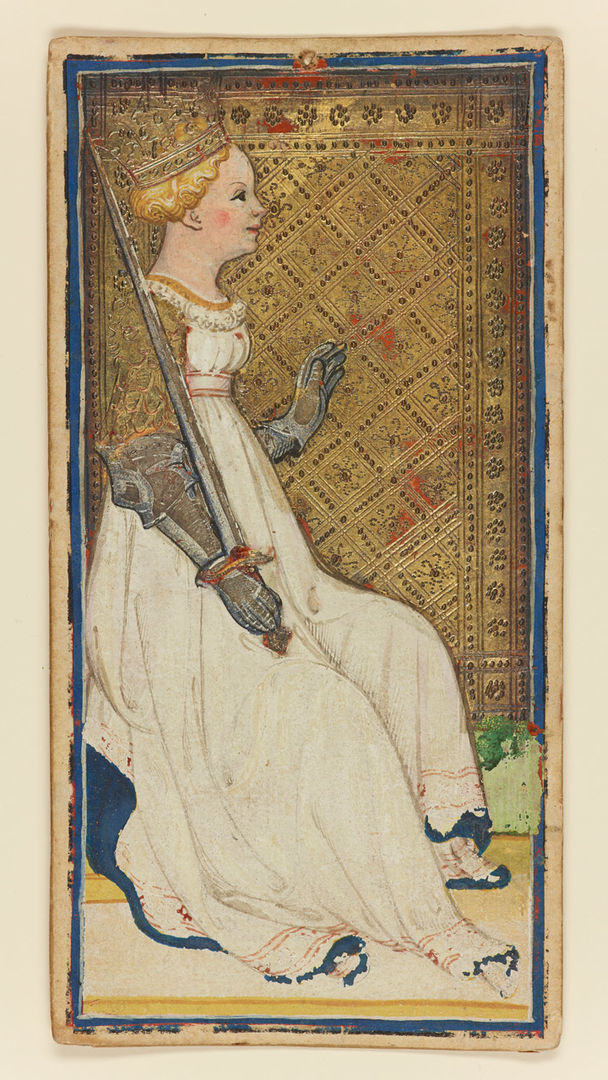
Workshop of Bonifacio Bembo (Italian, Cremonese, active ca. 1442–died before 1482). Queen of Swords, from The Visconti-Sforza Tarot, ca. 1450. Made in Milan, Italy. Paper (pasteboard) with opaque paint on tooled gold ground; 6 3/4 x 7 3/8 in. (17.3 x 8.7 cm). The Morgan Library & Museum, New York (MS M.630.23)
By the middle of the 15th century, the suit symbols of Italian cards were Cups, Swords, Batons, and Coins, and they remain so to this day. The pip cards were conventionally organized, with the repetition of the symbol indicating the value. In tarot cards, however, 21 trump cards, or tarocchi, were added, and these were figural, as in The Courtly Household Cards, with the fool at the bottom leading up to the emperor and pope at the top.
The earliest references to tarot all date to the 1440s and 1450s and fall within the quadrilateral defined by the northern cities of Venice, Milan, Florence, and Urbino. Because of the complicated nature of the game by that point, it is likely that it had begun evolving earlier in the century. Tarot cards employed the standard Italian suits, with values from 10 to 1 and with four face cards—king, queen, knight, and knave—for a total of 56 cards. Alongside them were a fool (matto), which was a wild card, and the 21 trump cards.
Tarot is a game of trick taking, as the many trump cards clearly indicate, and even though there are many variations (mostly minor), the rules of the game likely have not changed significantly since the 15th century. The present-day association of tarot with fortune-telling and the occult gained currency only in the 19th century and has nothing to do with the medieval tarot cards.
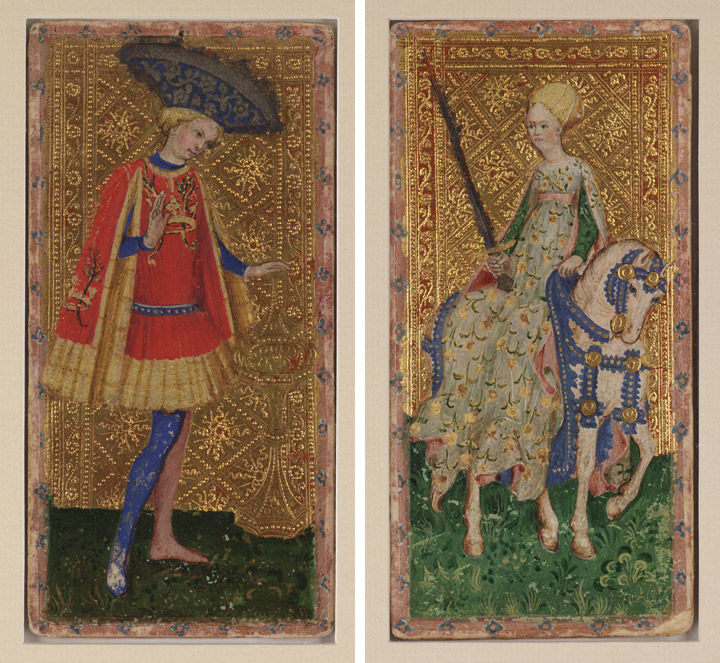
Left: Workshop of Bonifacio Bembo (Italian, Cremonese, active ca. 1442–died before 1482). Knave of Cups, from The Visconti Tarot, ca. 1450. Paper (pasteboard) with opaque paint on tooled gold ground; 7 3/8 x 3 1/2 in. (18.9 x 9 cm). Beinecke Rare Book & Manuscript Library, Yale University, New Haven, Connecticut (ITA 109). Right: Workshop of Bonifacio Bembo (Italian, Cremonese, active ca. 1442–died before 1482). Knight (female) of Swords, from The Visconti Tarot, ca. 1450. Paper (pasteboard) with opaque paint on tooled gold ground; 7 3/8 x 3 1/2 in. (18.9 x 9 cm). Beinecke Rare Book & Manuscript Library, Yale University, New Haven, Connecticut (ITA 109)
Trump cards are thought to have been invented in Europe, but perhaps not in Italy. The first trump-card game appears to have originated in Germany in the 1420s with a game known as Karnöffel, in which a suit of trump cards could beat only cards of a lower rank. Tarot and Karnöffel developed independently, and all subsequent trump games appear to have derived solely from tarot.
Three luxury tarot decks have survived from the mid-15th century. One of the decks is thought to have been made for Filippo Maria Visconti, the last duke of Milan of that name, prior to his death in 1447. Known as The Visconti Tarot, the deck’s 69 surviving cards are preserved in Yale University’s Beinecke Rare Book & Manuscript Library.
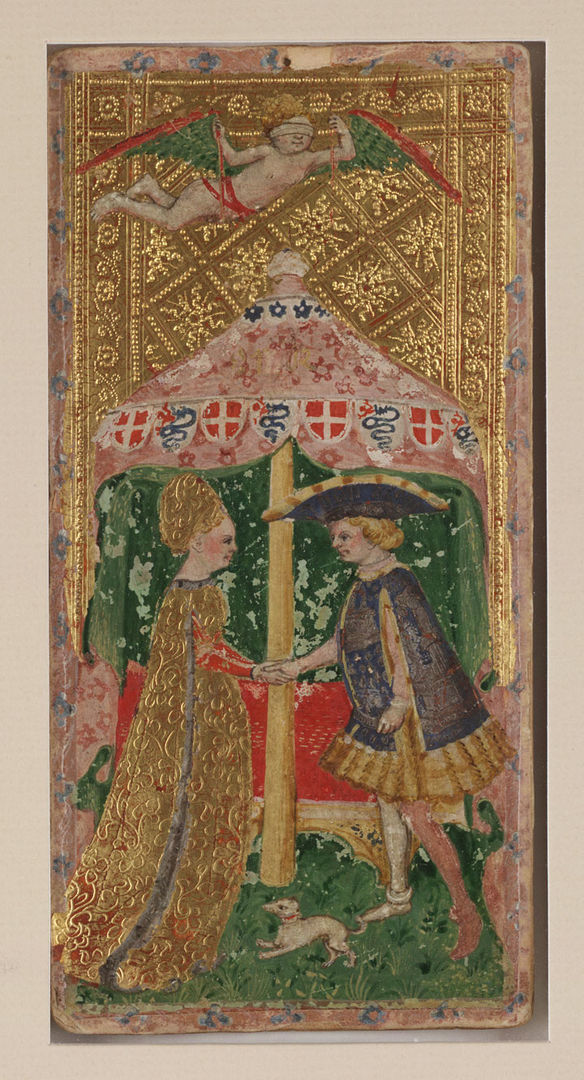
Workshop of Bonifacio Bembo (Italian, Cremonese, active ca. 1442–died before 1482). Love, from The Visconti Tarot, ca. 1450. Made in Milan, Italy. Paper (pasteboard) with opaque paint on tooled gold ground; 7 3/8 x 3 1/2 in. (18.9 x 9 cm). Beinecke Rare Book & Manuscript Library, Yale University, New Haven, Connecticut (ITA 109)
The other deck was more than likely made for Francesco Sforza, a mercenary commander who served in both Milan and Venice and married the only child of Filippo Maria Visconti. Known as The Visconti-Sforza Tarot, the deck was made sometime shortly after 1450. It is now divided: 26 of the surviving cards are at the Accademia Carrara, Bergamo and 35 are at the Morgan Library & Museum, New York. A third luxury deck, known as The Brambilla Deck (after a former owner), was almost certainly painted for Visconti before his death in 1447 and can be found at the Pinacoteca di Brera, Milan. All three decks are attributed to the workshop of the Milan court painter Bonifacio Bembo.
In The Visconti-Sforza Tarot, the highest trump is the world, followed by the angels. The remaining trump cards, in descending order, are the sun, moon, star, temperance, death, traitor, old man, wheel of fortune, fortitude, chariot, justice, love, pope, emperor, popess, empress, and mountebank, followed by the fool. The Visconti Tarot, the older pack, diverges from the standard: it has as many as six court cards per suit, including a male and female of all ranks. In addition to the more usual trumps, it also includes three theological virtues: faith, hope, and charity. It is uncertain if this pack was uniquely structured or if it represents an earlier stage before the tarots were standardized.
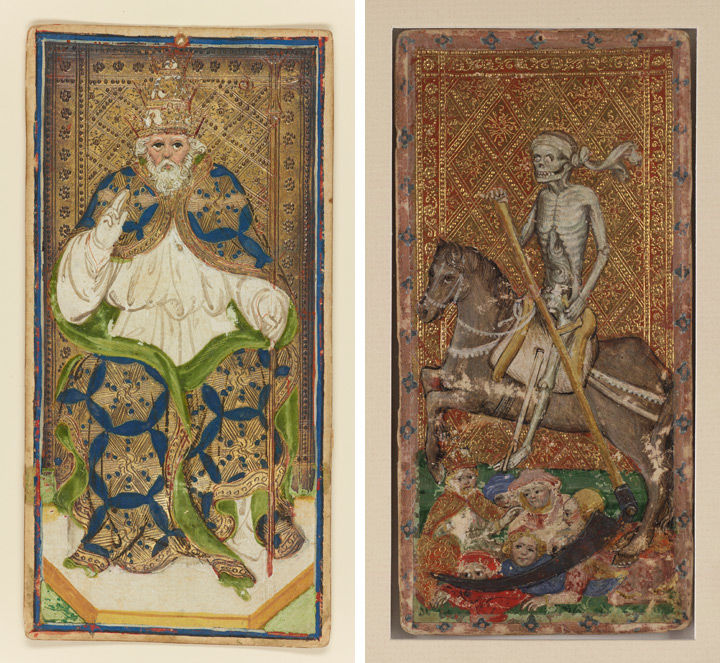
Left: Workshop of Bonifacio Bembo (Italian, Cremonese, active ca. 1442–died before 1482). Pope, from The Visconti-Sforza Tarot, ca. 1450. Made in Milan, Italy. Paper (pasteboard) with opaque paint on tooled gold ground; 6 3/4 x 7 3/8 in. (17.3 x 8.7 cm). The Morgan Library & Museum, New York (MS M.630.4). Right: Death, from The Visconti-Sforza Tarot, ca. 1450. Made in Milan, Italy. Paper (pasteboard) with opaque paint on tooled gold ground; 6 3/4 x 7 3/8 in. (17.3 x 8.7 cm). Beinecke Rare Book & Manuscript Library, Yale University, New Haven, Connecticut (ITA 109)
Related Link
Met Blogs: View all blog posts related to this exhibition.
Department: Medieval Art and The Cloisters
Tags: The Met Cloisters, The Visconti-Sforza Tarot, The Visconti Tarot, The World in Play: Luxury Cards, 1430–1540